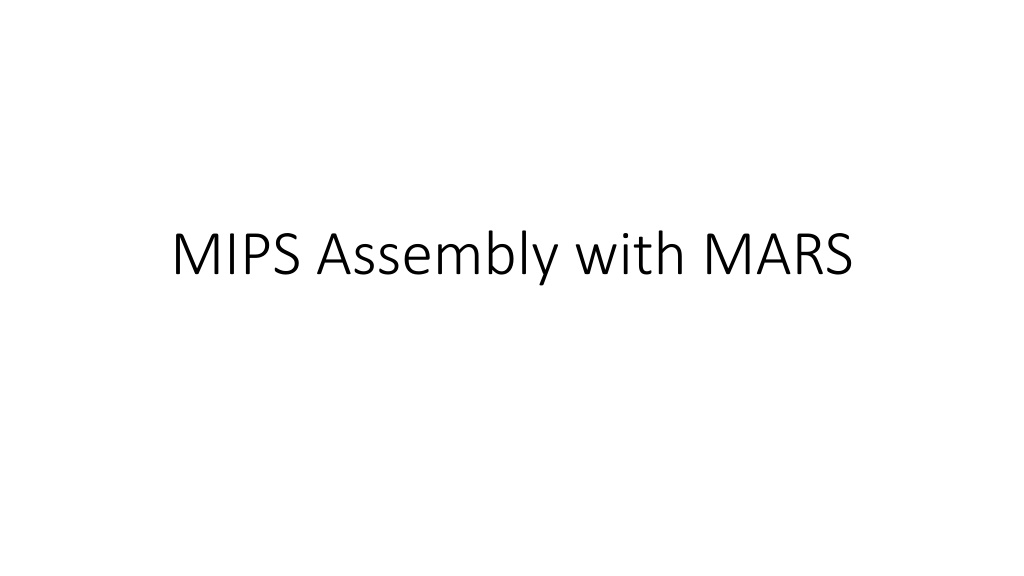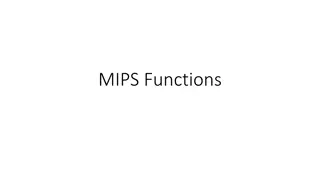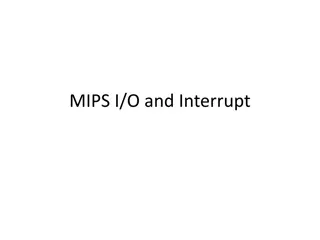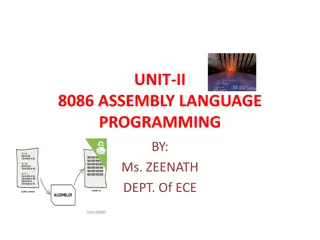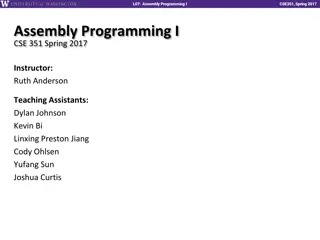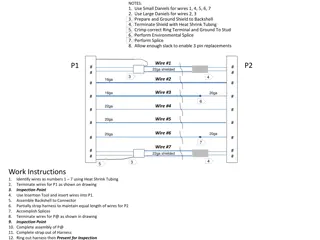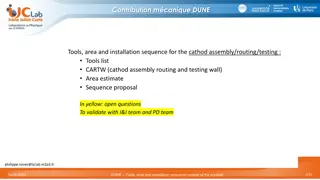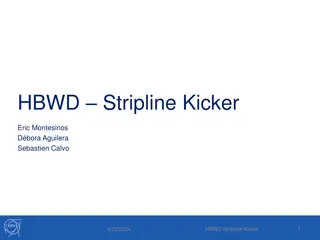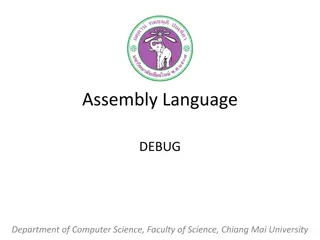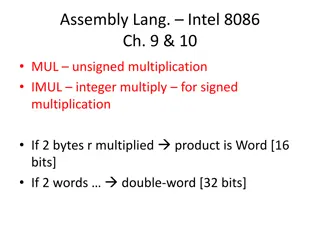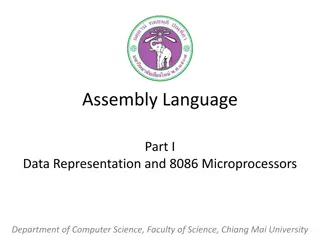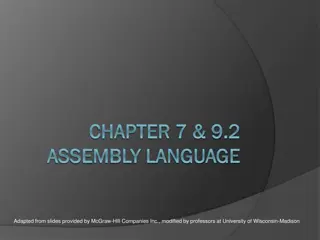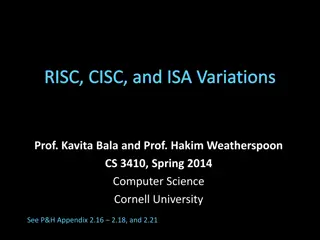Introduction to MIPS Assembly Programming with MARS
Introduction to MIPS Assembly Programming with MARS including instructions, I-Type format, register initialization, addi instructions, and translation to machine code using an assembler. Learn how to perform basic arithmetic operations in MIPS assembly language.
Uploaded on Sep 28, 2024 | 0 Views
Download Presentation

Please find below an Image/Link to download the presentation.
The content on the website is provided AS IS for your information and personal use only. It may not be sold, licensed, or shared on other websites without obtaining consent from the author. Download presentation by click this link. If you encounter any issues during the download, it is possible that the publisher has removed the file from their server.
E N D
Presentation Transcript
First Instructions and execution of an Assembly Simple program to compute 7+9 Inorder to perform this operation, we need to initialize two registers with these values, and perform addition with add instruction.
I-Type Immediate-type 3 operands: rs, rt: register operands imm: 16-bit two s complement immediate Other fields: op: the opcode Simplicity favors regularity: all instructions have opcode Operation is completely determined by the opcode I-Type rs rt imm op 6 bits 5 bits 5 bits 16 bits
How to initialize registers: $0 register is a special register that contains 0(zero) all the time. You can not change its content. Add Immediate addi Rt, Rs, Imm # RF[Rt] = RF[Rs] + Imm Add contents o f Reg.File [Rs] t o sign extended (se) Imm value; store result in Reg.File[Rt] . If overflow occurs in the two's complement number system, an exception is generated. Imm is the value to be stored in Rt register Ex: addi $3,$0,7
addi $3,$0,7 Code in Hex 0x20030007 2 0 0 3 0 0 0 7 0010 0000 0000 0011 0000 0000 0000 0111 001000 OpCode 00000 rs 00011 rt 0000000000000111 16-bit Immediate 2 sc value
addi $4,$0,9 0x20040009 0010 0000 0000 0100 0000 0000 0000 1001 (group of 4 bits) Re-group bits based on following format 001000 00000 00100 0000000000001001
add $5,$3,$4 Format:ADD rd, rs, rt 0x00642820 0000 0000 0110 0100 0010 1000 0010 0000 000000 00011 00100 00101 00000 100000
Assembly to machine code translation Translation into machine code (for simple programs can be done by users) is done by a special program called ASSEMBLER that traslates the Mnemonic program into machine code. Assembly code Machine Code Explanation addi $3,$0,7 0x20030007 addi $4,$0,9 0x20040009 add $5,$3,$4 This program compiled can converted into machine code that that is 3 32 bit values. These codes will be loaded into memory. 0x00642820 0x20030007 Machine code for performing 7+9 0x20040009 0x00642820
MIPS Programming Model a representative simple RISC machine Processor State (inside the CPU) Main Memory Fetch/Execute loop: PC 00 fetch Mem[PC] PC = PC + 4 execute fetched instruction (may change PC!) repeat! Addresses 31 0 0 4 8 3 2 1 0 000000....0 r0 r1 r2 32 bit words (4 bytes) 16 20 MIPS uses byte memory addresses. However, each instruction is 32-bits wide, and *must* be aligned on a multiple of 4 (word) address. Each word contains four 8-bit bytes. Addresses of consecutive instructions (words) differ by 4. next instruction 0x20030007 ... 32 bit words 0x20040009 r31 0x00642820 General Registers: A small scratchpad of frequently used or temporary variables
To execute the program the PC is loaded with the addres of the first instruction of the program. In MARS simulator this is 0x00 40 00 00 Memory Content 0x00400000 0x20030007 0x00400004 0x20040009 0x00400008 0x00642820 At the next fetch cycle, the first instruction (0x20030007 ) is brought into CPU (particularly Instruction Register) instruction is decoded and execution of this instruction is performed.
The Power of the Stored Program 32-bit instructions and data stored in memory Sequence of instructions: only difference between two applications (for example, a text editor and a video game) To run a new program: No rewiring required Simply store new program in memory The processor hardware executes the program: fetches (reads) the instructions from memory in sequence performs the specified operation The program counter (PC) keeps track of the current instruction In MIPS, programs typically start at memory address 0x00400000
Interpreting Machine Language Code Start with opcode Opcode tells how to parse the remaining bits If opcode is all 0 s R-type instruction Function bits tell what instruction it is Otherwise opcode tells what instruction it is Machine Code Field Values rt Assembly Code rs rt op imm op rs imm (0x2237FFF1) 8 17 23 -15 001000 10001 10111 1111 1111 1111 0001 addi $s7, $s1, -15 2 2 3 7 F F F 1 op rs rt rd shamt funct rs rt op rd shamt funct (0x02F34022) 000000 10111 10011 01000 00000 100010 0 23 19 8 0 34 sub $t0, $s7, $s3 2 F 3 0 2 0 4 2
Logical Instruction Examples Source Registers $s1 1111 1111 1111 1111 0000 0000 0000 0000 $s2 0100 0110 1010 0001 1111 0000 1011 0111 Assembly Code Result $s3 and $s3, $s1, $s2 $s4 or $s4, $s1, $s2 $s5 xor $s5, $s1, $s2 $s6 nor $s6, $s1, $s2
Logical Instruction Examples Source Registers $s1 1111 1111 1111 1111 0000 0000 0000 0000 $s2 0100 0110 1010 0001 1111 0000 1011 0111 Assembly Code Result $s3 0100 0110 1010 0001 0000 0000 0000 0000 and $s3, $s1, $s2 $s4 1111 1111 1111 1111 1111 0000 1011 0111 or $s4, $s1, $s2 $s5 1011 1001 0101 1110 1111 0000 1011 0111 xor $s5, $s1, $s2 $s6 0000 0000 0000 0000 0000 1111 0100 1000 nor $s6, $s1, $s2
Logical Instruction Examples Source Values $s1 0000 0000 0000 0000 0000 0000 1111 1111 imm 0000 0000 0000 0000 1111 1010 0011 0100 zero-extended Assembly Code andi $s2, $s1, 0xFA34 Result $s2 $s3 $s4 ori $s3, $s1, 0xFA34 xori $s4, $s1, 0xFA34
Logical Instruction Examples Source Values $s1 0000 0000 0000 0000 0000 0000 1111 1111 imm 0000 0000 0000 0000 1111 1010 0011 0100 zero-extended Assembly Code andi $s2, $s1, 0xFA34 Result $s2 0000 0000 0000 0000 0000 0000 0011 0100 $s3 0000 0000 0000 0000 1111 1010 1111 1111 ori $s3, $s1, 0xFA34 $s4 0000 0000 0000 0000 1111 1010 1100 1011 xori $s4, $s1, 0xFA34
Shift Instructions sll: shift left logical Example:sll $t0, $t1, 5 # $t0 <= $t1 << 5 srl: shift right logical Example:srl $t0, $t1, 5 # $t0 <= $t1 >> 5 sra: shift right arithmetic Example:sra $t0, $t1, 5 # $t0 <= $t1 >>> 5 Variable shift instructions: sllv: shift left logical variable Example:sllv $t0, $t1, $t2 # $t0 <= $t1 << $t2 srlv: shift right logical variable Example:srlv $t0, $t1, $t2 # $t0 <= $t1 >> $t2 srav: shift right arithmetic variable Example: srav $t0, $t1, $t2 # $t0 <= $t1 >>> $t2
Shift Instructions Assembly Code Field Values rt op rs rd shamt funct 0 0 17 8 2 0 sll $t0, $s1, 2 0 0 17 18 2 2 srl $s2, $s1, 2 0 0 17 19 2 3 sra $s3, $s1, 2 6 bits 5 bits 5 bits 5 bits 5 bits 6 bits Machine Code rs rt op rd shamt funct 000000 00000 10001 01000 00010 000000 (0x00114080) 000000 00000 10001 10010 00010 000010 (0x00119082) 000000 00000 10001 10011 00010 000011 (0x00119883) 6 bits 5 bits 5 bits 5 bits 5 bits 6 bits
Generating Constants 16-bit constants using addi: High-level code // int is a 32-bit signed word int a = 0x4f3c; MIPS assembly code # $s0 = a addi $s0, $0, 0x4f3c 32-bit constants using load upper immediate (lui) and ori: (lui loads the 16-bit immediate into the upper half of the register and sets the lower half to 0.) High-level code MIPS assembly code # $s0 = a lui $s0, 0xFEDC ori $s0, $s0, 0x8765 int a = 0xFEDC8765;
Memory Access Memory Access Instructions Instructions How to copy data from memory into registers, and how to copy data to memory from registers.
Load and Store instructions The MIPS architecture is a Load/Store architecture, which means that the only instructions that access main memory are the load and store instructions. Only one addressing mode is implemented in the hardware.
Load Load and The operands for all arithmetic and logic operations are contained in registers. To operate on data in main memory, the data is first copied into registers. and Store Store A load operation copies data from main memory into a register. A store operation copies data from a register into main memory . When a word (4 bytes) is loaded or stored the memory address must be a multiple of four. This is called an alignment restriction. Addresses that are a multiple of four are called word aligned. This restriction makes the hardware simpler and faster.
word aligned word aligned How can you multiply by four in binary? By shifting left 2 positions. Therefore a multiple of 4 looks like some N shifted left two positions. So the low order two bits of a multiple of 4 are both 0. 0x000AE430 Yes. 0x00014432 No. 0x000B0737 No. 0x0E0D8844 Yes.
lw and sw instructions The lw instruction loads a word into a register from memory. The sw instruction stores a word from a register into memory. Each instruction specifies a register and a memory address.
MIPS MIPS Addresses Addresses The MIPS instruction that loads a word into a register is the lw instruction. The store word instruction is sw. Each must specify a register and a memory address. A MIPS instruction is 32 bits (always). A MIPS memory address is 32 bits (always). How can a load or store instruction specify an address that is the same size as itself? An instruction that refers to memory uses a base register and an offset(ordisplacement). The base register is a general purpose register that contains a 32-bit address. The offset is a 16-bit signed integer contained in the instruction. The sum of the address in the base register with the (sign-extended) offset forms the memory address.
Example Load word instruction in assembly language: lw $d,off($b) # $d <-- Word from memory address b+off # $b is a register. off is 16-bit two's complement. # (The data from memory is available in $d after # a one machine cycle delay.) At execution time two things happen: 1. an address is calculated by adding the base register b with the offset off, and 2. data is fetched from memory at that address. The base address is always the content of one of the registers in the register file. The displacement is always a 16-bit constant. The constant value can range from - 32,768 (-2^16 ) to + 32,764 ( (2^16) - 4 )
Example Following example the instruction loads the word at address 0x00400060 into register $6. Assume that register $7 contains 0x00400000. 0x00400060 --- address of data 0x00400000 --- address in $10 $8 --- destination register The instruction is: lw $6,0x60($7) # $6<--------Memory[0x60+$7]
store word instruction sw $s1, 12( $a0 ) When the hardware executes this instruction it will compute the effective address of the destination memory location by adding together the contents of register $a0 and the constant value 12 Mem [ $a0 + 12] <- $s1 A copy of the contents of register $s1 is stored in memory at the effective address.
Consider given registers $12 and $13 and memory. Write the instruction that puts the word 0xFFFFFFFF into memory location 0x0004000C. Register $12 contains 0xFFFFFFFF Register $13 contains 0x00040014 Memory Addresses 00000005 00040014 00000004 00040010 sw $12 , 0xFFF8($13) or sw $12 , -8($13) 00000003 0004000C 00000002 00040008 00000001 00040004 00000000 00040000
How How to to initialize initialize the Base By using a 32-bit base register and an offset a 32-bit lw or sw instruction can reference all of memory. But how does the base address get into the base register? the Base Register Register(32 (32- -bits) bits) This is where the lui (load upper immediate) instruction is useful. It copies its 16-bit immediate operand to the upper two bytes of the designated register. lui $d,const # upper two bytes of $d < two byte const # lower two bytes of $d < 0x0000
For example, say that memory is as in the picture, and that you want to load the word at 0x00040010 into $12. The lui instruction can set up the base register: Memory Addresses 00000005 00040014 lui $13, 0x0004 lw $12, 0x10($13) 00000004 00040010 00000003 0004000C 00000002 00040008 00000001 00040004 00000000 00040000 After the lui instruction $13 contains 0x00040000. To get to the address we need, use an offset of 0x10.
Filling in the bottom Filling in the bottom Half Half By using the lui instruction, the base register can be loaded with multiples of 0x00010000. But often you want a more specific address in the base register. Use the ori instruction to fill the bottom 16 bits. ori $d,$s,imm zero-extends imm to 32 bits then does a bitwise OR of that with the contents of register $s. The result goes into register $d.
The lw instruction (below) loads the word at 0x0060500C into $12. lui $13, 0x0060 ori $13, $13, 0x5000 lw $12, 0xC($13) The above ori instruction "fills in" the lower 16 bits of register $13 by doing the following: $13 after lui zero-extended imm. op. : 0000 0000 0000 0000 0101 0000 0000 0000 result of bitwise OR : 0000 0000 0110 0000 0101 0000 0000 0000 : 0000 0000 0110 0000 0000 0000 0000 0000
Multiplication, Division Special registers: lo, hi 32 32 multiplication, 64 bit result mult $s0, $s1 Result in {hi, lo} 32-bit division, 32-bit quotient, 32-bit remainder div $s0, $s1 Quotient in lo Remainder in hi Moves from lo/hi special registers mflo $s2 mfhi $s3
Branching Allows a program to execute instructions out of sequence. Types of branches: Conditional branches branch if equal (beq) branch if not equal (bne) Unconditional branches jump (j) jump register (jr) jump and link (jal)
Review: The Stored Program Assembly Code Machine Code lw $t2, 32($0) 0x8C0A0020 add $s0, $s1, $s2 0x02328020 addi $t0, $s3, -12 0x2268FFF4 sub $t0, $t3, $t5 0x016D4022 Stored Program Instructions Address 0040000C 0 1 6 D 4 0 2 2 00400008 2 2 6 8 F F F 4 00400004 0 2 3 2 8 0 2 0 PC 00400000 8 C 0 A 0 0 2 0 Main Memory
Conditional Branching (beq) # MIPS assembly addi $s0, $0, 4 addi $s1, $0, 1 sll $s1, $s1, 2 beq $s0, $s1, target # branch is taken addi $s1, $s1, 1 # not executed sub $s1, $s1, $s0 # $s0 = 0 + 4 = 4 # $s1 = 0 + 1 = 1 # $s1 = 1 << 2 = 4 # not executed target: add $s1, $s1, $s0 # label # $s1 = 4 + 4 = 8 Labels indicate instruction locations in a program. They cannot use reserved words and must be followed by a colon (:).
The Branch Not Taken (bne) # MIPS assembly addi addi sll bne addi sub $s0, $0, 4 # $s0 = 0 + 4 = 4 $s1, $0, 1 # $s1 = 0 + 1 = 1 $s1, $s1, 2 # $s1 = 1 << 2 = 4 $s0, $s1, target # branch not taken $s1, $s1, 1 # $s1 = 4 + 1 = 5 $s1, $s1, $s0 # $s1 = 5 4 = 1 target: add $s1, $s1, $s0 # $s1 = 1 + 4 = 5
Unconditional Branching / Jumping (j) # MIPS assembly addi $s0, $0, 4 addi $s1, $0, 1 j target sra $s1, $s1, 2 addi $s1, $s1, 1 sub $s1, $s1, $s0 # $s0 = 4 # jump to target # not executed # not executed # not executed # $s1 = 1 target: add $s1, $s1, $s0 # $s1 = 1 + 4 = 5
Unconditional Branching (jr) # MIPS assembly 0x00002000 addi $s0, $0, 0x2010 0x00002004 jr $s0 0x00002008 addi $s1, $0, 1 0x0000200C sra $s1, $s1, 2 0x00002010 lw $s3, 44($s1)
High-Level Code Constructs if statements if/else statements while loops for loops
If Statement High-level code MIPS assembly code # $s0 = f, $s1 = g, $s2 = h # $s3 = i, $s4 = j if (i == j) f = g + h; f = f i;
If Statement High-level code MIPS assembly code # $s0 = f, $s1 = g, $s2 = h # $s3 = i, $s4 = j bne $s3, $s4, L1 add $s0, $s1, $s2 if (i == j) f = g + h; f = f i; L1: sub $s0, $s0, $s3 Notice that the assembly tests for the opposite case (i != j) than the test in the high-level code (i == j).
If / Else Statement High-level code MIPS assembly code # $s0 = f, $s1 = g, $s2 = h # $s3 = i, $s4 = j if (i == j) f = g + h; else f = f i;
If / Else Statement High-level code MIPS assembly code # $s0 = f, $s1 = g, $s2 = h # $s3 = i, $s4 = j bne $s3, $s4, L1 add $s0, $s1, $s2 j done L1: sub $s0, $s0, $s3 done: if (i == j) f = g + h; else f = f i;
